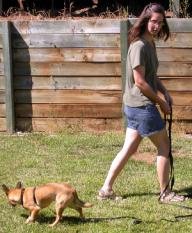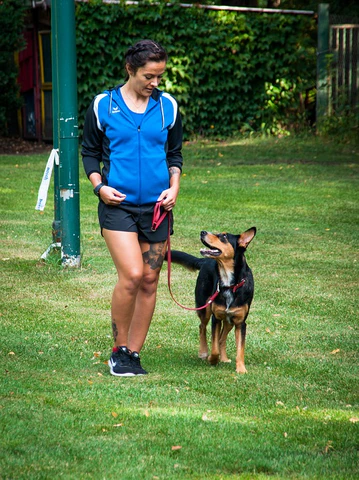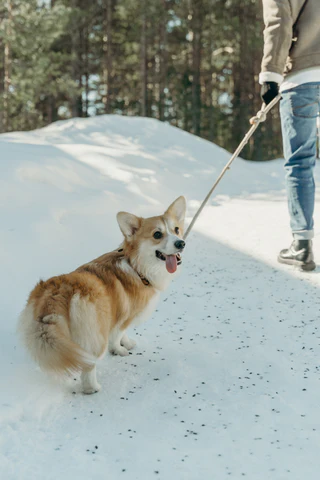Training a dog to walk calmly on a leash may sound simple in theory, but in practice, it’s one of the more challenging tasks for dog owners—especially with puppies full of energy and curiosity. You might dream of leisurely strolls with your furry companion trotting happily at your side, stopping when you stop, turning when you turn, and ignoring distractions like squirrels or passersby. That dream can become a reality with patience, consistency, and the right approach to leash training.
Setting the Stage: Equipment That Helps Without Doing the Work
Before you start training, it’s important to choose the right gear. While tools like front-attachment harnesses and head collars can reduce pulling, they’re not a substitute for actual leash training. They simply make the process easier and safer.
A front-attachment harness, ideal for most dogs, gently discourages pulling without restricting movement. For large or strong dogs—especially if you’re a smaller person—a head collar can offer more control, particularly in high-distraction environments. Keep in mind, both tools work best with a standard 6-foot leash. Anything longer increases the risk of injury if your dog lunges suddenly.
The Basics of Leash Training: From Backyard to Sidewalk
Training begins at home, ideally in a quiet, familiar environment like your backyard. Start with a long leash (10–20 feet, non-retractable) and a standard harness. Choose a side—left or right—for your dog to walk on, and consistently reinforce that side as the “reward zone” with treats.

Use high-value treats—small bits of fresh meat or cheese—to catch your dog’s attention. Walk randomly around your yard, and each time your dog voluntarily walks by your side, immediately reward them with a treat at thigh level. Over time, your dog will begin to associate that position with rewards and will choose to walk there more often.
If your dog loses interest, don’t force the session. Simply stop and try again later when your dog might be more food-motivated.
Teaching Focus and Direction
Once your dog is comfortable walking at your side, it’s time to add the next layer: attention. During walks, if your dog lags behind or veers off to sniff, use an upbeat “let’s go” to encourage them to return. A thigh pat can help get their attention early in training. When they return to your side, reward with praise and a treat.
Should your dog pull or ignore you, stop walking and gently apply leash pressure—not to drag, but to signal that walking away from you isn’t rewarding. The moment they turn toward you, release the pressure and reward. This reinforces that staying near you is both comfortable and rewarding.

Structured Sniff Breaks
Dogs experience the world through their nose, and sniffing is an important part of their mental stimulation. However, letting them decide when and where to sniff can encourage pulling. Instead, build sniff breaks into your walk as a reward. Every few minutes, say “go sniff” and allow a short, controlled break. If they begin to pull, calmly say “let’s go” and walk in the opposite direction to end the break.
This reinforces your role as the one who sets the pace and activities during walks, while still respecting your dog’s need to explore.
Increasing the Challenge
As your dog improves, shorten the leash to 6 feet and begin to introduce new challenges. Change speeds, stop abruptly, turn without warning—reward your dog for staying by your side through all of it. Begin reducing the frequency of rewards during standard walking, but continue to reinforce good behavior during tougher moments, such as encountering another dog or a distraction.
Taking It to the Streets
Once your dog is reliable in the yard, it’s time to try real-world walks. These environments are full of temptations—strangers, dogs, sounds, smells—so be patient. Use the same methods: start with “let’s go,” turn away from distractions if your dog pulls, and reward generously for walking calmly beside you. If you anticipate a particularly distracting route, equip your dog with a front-attachment harness or head collar for added support.
Don’t forget those authorized sniff breaks—they’re still important!

Advanced Leash Training: Walking Past Distractions
To further solidify polite leash behavior, try this exercise: while holding the leash, toss a toy or treat a short distance ahead. If your dog pulls to reach it, calmly say “let’s go” and walk in the opposite direction. If your dog walks politely beside you toward the object, let them have it as a reward.
This teaches your dog that walking with you—even in exciting situations—is the key to getting what they want.
Troubleshooting Common Issues
- Crossing in front of you: Shuffle your feet or gently nudge to remind your dog where you are. Consistent side walking should be reinforced with treats.
- Lagging behind: This could indicate fear or fatigue. Encourage with praise and soft cues. Avoid dragging or yanking the leash.
- Intermittent pulling: If your dog alternates between pulling and walking calmly, stop rewarding them for simply returning to you after pulling. Instead, reward only after they take multiple consecutive steps at your side.
The “Heel” Command: Walking With Precision
The “heel” command teaches your dog to stay very close to you and focus intently—perfect for tight spaces or passing distractions. Start indoors with a treat in your closed fist. Say “let’s go” and walk a few steps with your dog following your hand. Reward often. Eventually, use an empty hand as a signal while still rewarding frequently. Gradually take this training outside and increase difficulty as your dog progresses.
Leash training a puppy—or even an older dog—requires dedication, but the rewards are well worth the time. A dog that walks calmly at your side turns daily walks into enjoyable adventures rather than frustrating tug-of-wars. With consistent practice, positive reinforcement, and a clear set of rules, you’ll be well on your way to stress-free strolls and a stronger bond with your dog.


